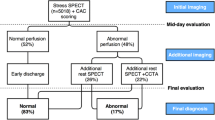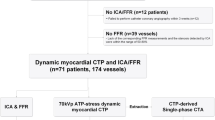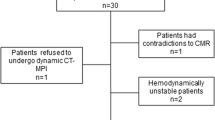Abstract
Purpose
To validate a new low-dose and rapid stepwise individualized algorithm for non-invasive assessment of ischemic coronary artery disease by sequential use of prospectively ECG-triggered low-dose CT coronary angiography (CTCA) and low-dose single-photon emission computed tomography myocardial perfusion imaging (SPECT-MPI).
Methods
Forty patients referred for elective invasive coronary angiography (CA) were prospectively enrolled to undergo a comprehensive non-invasive evaluation with low-dose CTCA and a dose-reduced stress/rest SPECT-MPI scan (using dedicated reconstruction algorithms for low count scans). The following algorithm was reviewed: CTCA first, followed by a stress-only MPI if a coronary stenosis (≥ 50% diameter narrowing) or equivocal findings were observed. Only abnormal stress MPI scans were followed by rest MPI. The accuracy of the individualized algorithm to predict coronary revascularization and its mean effective radiation dose were assessed.
Results
CTCA documented CAD in 18 and equivocal findings in two patients, thus, requiring additional stress MPI scans. Of these, 16 were abnormal, therefore requiring a rest MPI scan, revealing ischemia in 15 patients. Sensitivity, specificity, negative and positive predictive value, and accuracy of the individualized algorithm for predicting coronary revascularization was 93.3%, 96.0%, 96.0%, 93.3% and 95.0% on a per-patient base. The mean effective radiation dose was significantly lower for the individualized (4.8 ± 3.4 mSv) versus the comprehensive method (8.1 ± 1.5 mSv) resulting in a total population radiation dose reduction of 132.6 mSv.
Conclusion
This new individualized low-dose algorithm allows rapid and accurate prediction of invasive CA findings and of treatment decision with minimized radiation dose.


Similar content being viewed by others
References
Achenbach S, Daniel WG. Noninvasive coronary angiography-an acceptable alternative? N Engl J Med. 2001;345:1909–10.
Shaw LJ, Shaw RE, Merz CN, Brindis RG, Klein LW, Nallamothu B, et al. Impact of ethnicity and gender differences on angiographic coronary artery disease prevalence and in-hospital mortality in the American College of Cardiology-National Cardiovascular Data Registry. Circulation. 2008;117:1787–801.
Klocke FJ, Baird MG, Lorell BH, Bateman TM, Messer JV, Berman DS, et al. ACC/AHA/ASNC guidelines for the clinical use of cardiac radionuclide imaging-executive summary: a report of the American College of Cardiology/American Heart Association Task Force on Practice Guidelines (ACC/AHA/ASNC Committee to Revise the 1995 Guidelines for the Clinical Use of Cardiac Radionuclide Imaging). J Am Coll Cardiol. 2003;42:1318–33.
Schroeder S, Achenbach S, Bengel F, Burgstahler C, Cademartiri F, de Feyter P, et al. Cardiac computed tomography: indications, applications, limitations, and training requirements: report of a Writing Group deployed by the Working Group Nuclear Cardiology and Cardiac CT of the European Society of Cardiology and the European Council of Nuclear Cardiology. Eur Heart J. 2008;29:531–56.
Achenbach S, Ulzheimer S, Baum U, Kachelriess M, Ropers D, Giesler T, et al. Noninvasive coronary angiography by retrospectively ECG-gated multislice spiral CT. Circulation. 2000;102:2823–8.
Gaemperli O, Schepis T, Koepfli P, Valenta I, Soyka J, Leschka S, et al. Accuracy of 64-slice CT angiography for the detection of functionally relevant coronary stenoses as assessed with myocardial perfusion SPECT. Eur J Nucl Med Mol Imaging. 2007;34:1162–71.
Gaemperli O, Schepis T, Valenta I, Koepfli P, Husmann L, Scheffel H, et al. Functionally relevant coronary artery disease: comparison of 64-section CT angiography with myocardial perfusion SPECT. Radiology. 2008;248:414–23.
Namdar M, Hany TF, Koepfli P, Siegrist PT, Burger C, Wyss CA, et al. Integrated PET/CT for the assessment of coronary artery disease: a feasibility study. J Nucl Med. 2005;46:930–5.
Gaemperli O, Schepis T, Kalff V, Namdar M, Valenta I, Stefani L, et al. Validation of a new cardiac image fusion software for three-dimensional integration of myocardial perfusion SPECT and stand-alone 64-slice CT angiography. Eur J Nucl Med Mol Imaging. 2007;34:1097–106.
Gaemperli O, Schepis T, Valenta I, Husmann L, Scheffel H, Duerst V, et al. Cardiac image fusion from stand-alone SPECT and CT: clinical experience. J Nucl Med. 2007;48:696–703.
Rispler S, Keidar Z, Ghersin E, Roguin A, Soil A, Dragu R, et al. Integrated single-photon emission computed tomography and computed tomography coronary angiography for the assessment of hemodynamically significant coronary artery lesions. J Am Coll Cardiol. 2007;49:1059–67.
Husmann L, Valenta I, Gaemperli O, Adda O, Treyer V, Wyss CA, et al. Feasibility of low-dose coronary CT angiography: first experience with prospective ECG-gating. Eur Heart J. 2008;29:191–7.
Herzog BA, Husmann L, Burkhard N, Valenta I, Gaemperli O, Tatsugami F, et al. Low-dose CT coronary angiography using prospective ECG-triggering: impact of mean heart rate and heart rate variability on image quality. Acad Radiol. 2009;16:15–21.
Ali I, Ruddy TD, Almgrahi A, Anstett FG, Wells RG. Half-time SPECT myocardial perfusion imaging with attenuation correction. J Nucl Med. 2009;50:554–62.
Herzog BA, Husmann L, Burkhard N, Gaemperli O, Valenta I, Tatsugami F, et al. Accuracy of low-dose computed tomography coronary angiography using prospective electrocardiogram-triggering: first clinical experience. Eur Heart J. 2008;29:3037–42.
Tatsugami F, Husmann L, Herzog BA, Burkhard N, Valenta I, Gaemperli O, et al. Evaluation of a body mass index-adapted protocol for low-dose 64-MDCT coronary angiography with prospective ECG triggering. AJR Am J Roentgenol. 2009;192:635–8.
Giorgetti A, Rossi M, Stanislao M, Valle G, Bertolaccini P, Maneschi A, et al. Feasibility and diagnostic accuracy of a gated SPECT early-imaging protocol: a multicenter study of the Myoview Imaging Optimization Group. J Nucl Med. 2007;48:1670–5.
Hausleiter J, Meyer T, Hermann F, Hadamitzky M, Krebs M, Gerber TC, et al. Estimated radiation dose associated with cardiac CT angiography. JAMA. 2009;301:500–7.
Einstein AJ, Moser KW, Thompson RC, Cerqueira MD, Henzlova MJ. Radiation dose to patients from cardiac diagnostic imaging. Circulation. 2007;116:1290–305.
Radiation dose to patients from radiopharmaceuticals (addendum 2 to ICRP publication 53). Ann ICRP. 1998;28:1–126.
Lobotessi H, Karoussou A, Neofotistou V, Louisi A, Tsapaki V. Effective dose to a patient undergoing coronary angiography. Radiat Prot Dosimetry. 2001;94:173–6.
Husmann L, Herzog BA, Gaemperli O, Tatsugami F, Burkhard N, Valenta I, et al. Diagnostic accuracy of computed tomography coronary angiography and evaluation of stress-only single-photon emission computed tomography/computed tomography hybrid imaging: comparison of prospective electrocardiogram-triggering vs. retrospective gating. Eur Heart J. 2009;30:600–7.
Schuijf JD, Wijns W, Jukema JW, Atsma DE, de Roos A, Lamb HJ, et al. Relationship between noninvasive coronary angiography with multi-slice computed tomography and myocardial perfusion imaging. J Am Coll Cardiol. 2006;48:2508–14.
Cook S, Togni M, Walpoth N, Maier W, Mühlberger V, Legrand V, et al. Percutaneous coronary interventions in Europe 1992–2003. EuroIntervention. 2006;1:374–9.
Yoon AJ, Melduni RM, Duncan SA, Ostfeld RJ, Travin MI. The effect of beta-blockers on the diagnostic accuracy of vasodilator pharmacologic SPECT myocardial perfusion imaging. J Nucl Cardiol. 2009;16:358–67.
Acknowledgements
The study was supported by a grant from the Swiss National Science Foundation and by the ZIHP (Zurich Center for Integrative Human Physiology, University of Zurich, Switzerland). We are grateful to Ennio Mueller, Edlira Loga, Mirjam De Bloeme, Verena Weichselbaumer, and Josephine Trinckauf for their excellent technical support.
Disclosures
None
Author information
Authors and Affiliations
Corresponding author
Additional information
Aju P Pazhenkottil and Bernhard A Herzog contributed equally to this work
Christophe A Wyss and Philipp A Kaufmann shared last authorship
Rights and permissions
About this article
Cite this article
Pazhenkottil, A.P., Herzog, B.A., Husmann, L. et al. Non-invasive assessment of coronary artery disease with CT coronary angiography and SPECT: a novel dose-saving fast-track algorithm. Eur J Nucl Med Mol Imaging 37, 522–527 (2010). https://doi.org/10.1007/s00259-009-1273-z
Received:
Accepted:
Published:
Issue Date:
DOI: https://doi.org/10.1007/s00259-009-1273-z




